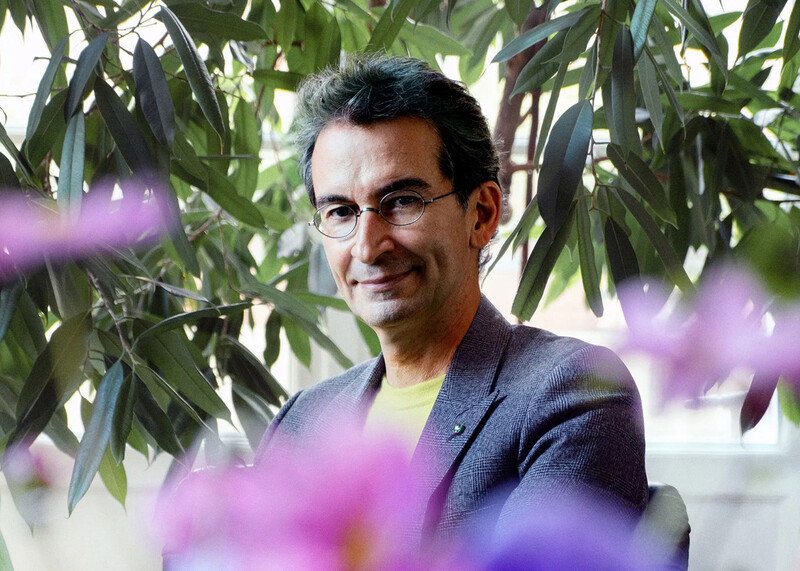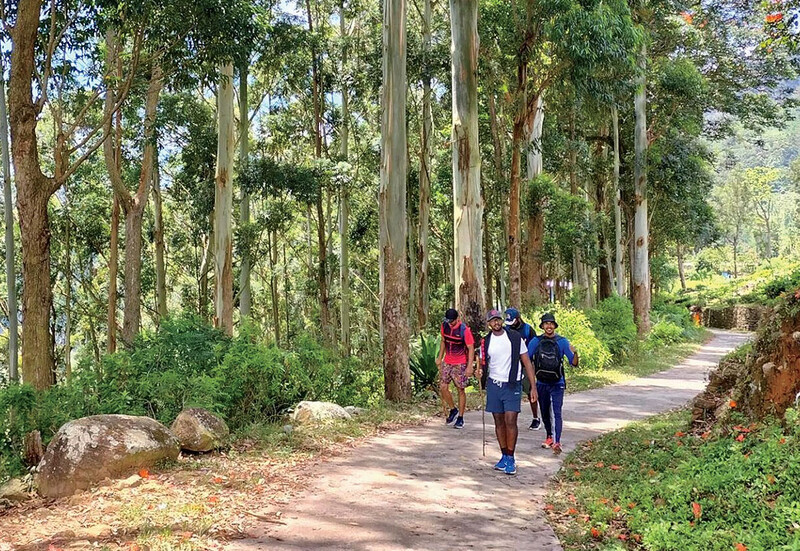
It was a minor item, just ten inches of copy. It ran on the fourth page of the San Francisco Chronicle on June 6, 1981, and carried no byline. “I thought it was so unimportant that I didn’t put my name on it,” says David Perlman ’39CC, ’40JRN. A PNEUMONIA THAT STRIKES GAY MALES, ran the headline. “And that was the start of it.”
By “it” Perlman means the reporting of the AIDS epidemic, which he covered for the newspaper until the 1990s. He arrived at the Chronicle in 1940 as a copy boy and started on the science beat in the late 1950s, at the dawn of the space race. Over time he filed stories on the advent of nuclear power and the earliest warnings of climate change. Last year, Perlman, ninety-eight, published some fifty articles, on everything from coral reefs to the search for extraterrestrial life.
“I’ll keep working till I drop dead at my desk,” Perlman once told the New York Times. “Unless the paper dies first.”
The Chronicle has occupied its namesake building at the corner of 5th and Mission since 1924. Perlman arrives most days around 9:30 a.m. In one of his few concessions to age, he carries a cane, which he juggles with his notebook.
He takes the same route every day. “I leave my house on 5th Avenue,” Perlman says, “drive down Geary, take Jones to Eddy, cross Market at 5th Street, and drive into the parking lot.” He got a new car, a Mazda compact, two years ago. “Goes like a bat out of hell,” he says.
Perlman’s office in the corner of the newsroom reflects the sensibility of a man whose first article was printed by mimeograph. There are precarious stacks of papers, and yellowed headlines tacked to the walls. Though Twitter’s headquarters are four blocks away, Perlman doesn’t tweet; he has an account, @daveperlman, but it got hacked, and he hasn’t tried to fix it. “I don’t pay attention to social media,” he says. “I should. I know that. But I’m out of that loop.” Still, his Twitter bio is appropriately terse: “Science editor, The San Francisco Chronicle since 1959.”
When Perlman arrived at Columbia, in the mid-1930s, College Walk was still a through street. South Hall — now Butler Library — had just been built. Perlman can even remember crossing paths with Sid Luckman ’39CC, the future NFL Hall of Fame quarterback.
“Columbia was the only college I applied to,” says Perlman, who grew up on the Upper West Side. But proximity wasn’t the only draw. It so happened that Columbia College, as Perlman tells it, “had the best daily newspaper of any university in the country.”
As a kid, Perlman had seen The Front Page, though he’s not sure if it was on Broadway, where it opened in 1928 and closed the following year, or in a movie theater, when the film version was released in 1931. Nonetheless, it made an impression. “It was such a romantic characterization,” Perlman says of the image of the tabloid scribes sitting around smoking in the pressroom of Chicago’s Criminal Courts Building.
In Perlman’s college days, the Spectator, along with the other student publications, was located on the fourth floor of John Jay Hall. (When informed that the newspaper is now based off-campus, on Broadway at West 112th Street, Perlman expresses shock. “My God,” he says.)
By his senior year, Perlman was editing the paper. “I majored in the Spectator,” he is fond of saying. Fortunately, his roommate took many of the same classes. “I really thrived on his notes,” Perlman says.
After graduating from Columbia’s journalism school in 1940, Perlman went to Bismarck, North Dakota, to join a local paper. “I did not cotton to that bucolic life,” he recalls. Some of his journalism-school classmates worked in San Francisco. “I sent them a telegram and said, ‘Get me out of here.’ And they did.”
But for a brief sojourn in Paris, where he wrote for the Herald Tribune after World War II, Perlman has been at the Chronicle ever since. In the summer of 1980, a young journalist named Erica Goode was placed under his watch.
“David is an extraordinary human being,” says Goode, who went on to have a distinguished career as a science writer and editor at the New York Times. “He basically looks the same now as he did when I first met him.” Goode credits Perlman’s youthful mien to his curiosity and enthusiasm. Perlman recently informed her that he planned to reduce his output from three or four articles per week to just one. Still, in the second week of January, he published two articles in two days.
Perlman is one of the few journalists for whom lifetime-achievement awards have been named who is, in fact, still living. Every year, the American Geophysical Union distributes the David Perlman Award for Excellence in Science Journalism. “If there could be said to be founders of science journalism,” Goode says, “he is definitely one of them.”
Perlman fell into his chosen craft. Literally. After breaking his leg skiing — “a heavily comminuted fracture,” he says, relishing the technical term for splintering — he was laid up in the hospital. This was in the 1950s, when science journalism as a discipline was still young.
While he was recuperating, a friend brought him a book about astronomy called The Nature of the Universe, by the English cosmologist Fred Hoyle. “I didn’t really give a damn about the subject,” Perlman says. But he was tired of reading detective stories, so he gave it a shot.
By the time he left the hospital, he had already made plans to visit an observatory in the Diablo Range, just east of San Jose. The first astronomer he met there studied the birth of stars in the Orion Nebula. “That was kind of an epiphany,” says Perlman. “Stars get born? Way out there in a nebula, in the sky?”
For Perlman, science journalism has always been about making the complex simple. “We try to explain what the science is in terms that people can understand,” Perlman says. Recently, he wrote an article on three newly discovered species of salamander. “I got a heck of a lot of e-mails,” he says, “people sending me photographs of salamanders in their own backyards.”
Many were convinced their salamanders belonged to the new species. But that was unlikely: as Perlman reported, the new salamanders, which belong to the genus Thorius, are already in danger of extinction.
Extinctions, diseases, climate change — in his seven decades of reporting, Perlman has covered some profoundly discouraging topics. Yet his outlook is one of optimism: progress is the general rule. “Everything that I’ve covered I’ve seen moving forward,” he says. AIDS is a case in point: in 1981, when he wrote his first article about a rare form of pneumonia appearing in gay men, AIDS didn’t have so much as a name.
“At the beginning of that mess,” Perlman says, “things looked so damn hopeless.” One of his colleagues, Randy Shilts, the pioneering gay journalist and activist, would die of AIDS. (“He was a committed guy and a hell of a reporter,” Perlman says of Shilts, who wrote the bestselling And the Band Played On, the definitive history of the epidemic’s early days.)
“And yet eventually,” Perlman notes, “the AIDS virus was isolated, the politics were overcome, and now we have all these anti-retroviral drugs. It hasn’t been that long since 1981.”
In 2002, Perlman lost his wife of more than sixty years, Anne, a poet and journalist whose work appeared in the Paris Review and Ploughshares, among other publications. He has three children, two of whom are retired, and three grandchildren. He also has a dinner date. “I don’t know what the term is these days,” says Perlman. “I have a very dear friend.”
He knows his scientific terms, though — and isn’t afraid to use them. “David has schooled me a few times in the decade or so I’ve been his editor,” says the Chronicle’s Terry Robertson. “Dumbing down science for the sake of the readers insults their intelligence. He holds fast to that.”
And given what he sees as the anti-science bent of the new administration, Perlman says good reporting is more important than ever. “I’m asking scientists of all kinds, particularly climate scientists, about their own fears,” he says. One of his chief concerns is President Trump’s budgeting for the satellites run by NASA and NOAA that track climate change. “Science is not — should not — be a controversial subject,” Perlman says.
As for his longevity and productivity, Perlman doesn’t necessarily have a scientific explanation. He attributes his staying power mostly to luck. “I don’t do anything I’m supposed to as far as health,” Perlman says. “I don’t exercise. I don’t watch what I eat.”
What he does do is stay engaged. Cane and notebook in hand, Perlman still attends science conferences, looking for stories to write.
“Every time I’ve written a story,” he says, “I’ve learned something.”
Some things never get old.



